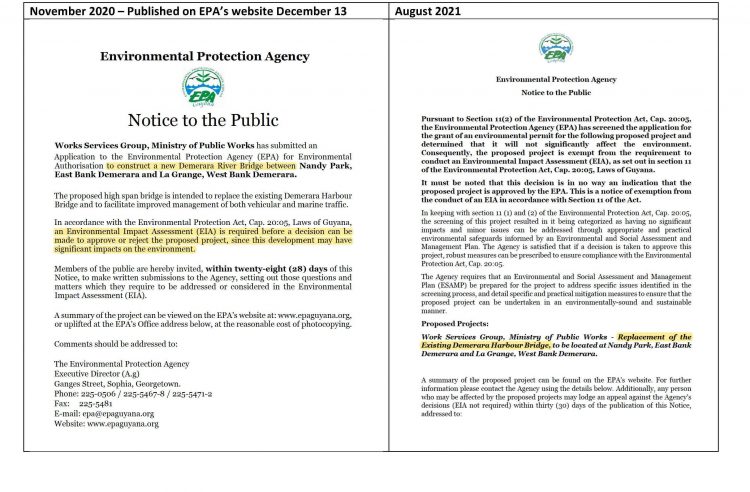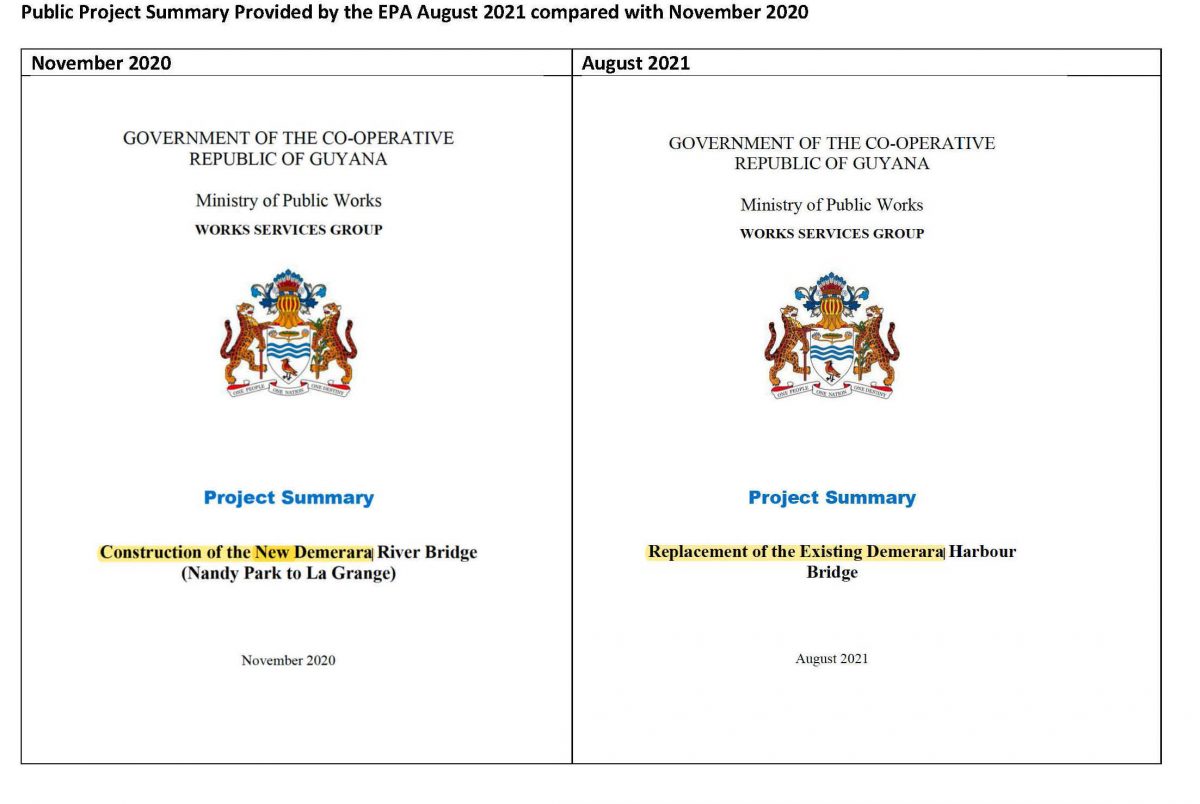Environmentalist Simone Mangal-Joly has written to the Environmental Assessment Board (EAB) objecting to the EPA’s decision not to require an impact assessment for the new bridge over the Demerara River and pointing out that it was a reversal of an earlier position that one was needed.
Mangal-Joly in her correspondence of August 27th 2021 to the EAB – the body which determines appeals of decisions by the Environmental Protection Agency (EPA) – also pointed out that the EPA was now describing the bridge as a replacement and not a new one, as it had previously done, even though entirely different construction and engineering methodologies were involved.
The EPA had prompted shock in some circles when on August 18 it said that an application for an environmental permit for the new bridge over the Demerara had been received and in its judgement it will not require an Environmental Impact Assessment (EIA). The public was then given 30 days to consider the EPA decision and whether an appeal should be lodged with the EAB.

Summary was grossly deficient and does not enable the public to exercise its right to rationally consider the proposed activity; (3) The reasons for the EPA’s decision that the impacts would be insignificant and not require an EIA were not provided.
She pointed out that the EPA’s notice of December 13, 2020 for the same project had stated that the effects would be significant and thus an EIA would be required.
“The EPA has since, with no explanation or material changes to the project, published an altered Project Summary and removed the EIA requirement”, she said.
The environmentalist pointed out that the first Project Summary published by the EPA in November 2020 described the project as “The New Demerara Harbour Bridge”. However, in the August 2021 Project Summary, the title of the project has been changed to: “Replacement of the Existing Demerara Harbour Bridge.”
Mangal-Joly pointed out that there are only two differences between the November 2020 Project Summary and the one in August. The first is that all references to a “new” bridge were transformed to “replacement” bridge and the reference to the conduct of an Environmental and Social Impact Assessment (ESIA) on pg. 4 of the November 2020 project summary was expunged. She noted that the Ministry of Public Works had accepted the need for an EIA and stated in the November version that it would hire a consultancy firm to execute one. In fact, she noted that the Government’s Department of Public Information twice issued public notices on the new bridge and the ESIA process (on December 10, 2020, and March 31, 2021).
“There is no justification in treating this project any differently from the one of November 2020
based simply on the exchange of the term `new’ with `replacement’. Further, The Demerara Harbour Bridge currently in existence is a floating bridge based on entirely different technology than the technology for the proposed new bridge. The activity for which an environmental permit is requested is not a mere swapping out of parts, or all parts, of the floating bridge. The activity is the construction of a new and different bridge based on different technology, and at a different location. The activity was authentically described in the November 2020 project summary. The only effect of the August 2021 project summary alterations is a misrepresentation of the project that serves to mislead the public”, Mangal-Joly stated in the letter.
She said that when the EPA first received the developer’s Permit Appli-cation, it took the view that the construction of the bridge would significantly affect the environment and, pursuant to the EPA Act, an EIA was necessary.
“It is a breach of public trust for the EPA to contradict its earlier position by discretely removing all references to the EIA and publishing an altered description of the project that downplays the reality of the proposed activity”, the environmentalist asserted.
Devoid
She also argued that the four-page summary for the bridge project is devoid of basic information to enable public participation as envisioned in Section 11 of the Environmental Protection Act (1996).
“For example, it does not provide a description of the type of bridge or materials that will be used in its construction. There is no mention of: the affected geographical footprint; activities that comprise the construction phase; alternatives considered; specific types of wastes that would be generated and disposal options; project size and investment; length of construction time; aerial extent of forests that will be removed or otherwise impacted and whether these forests contain protected species such as mangroves; potential traffic impacts during construction; adjacent communities on either side of the river that will be impacted during construction as well as operation of the bridge etc”, she said.
She stated that Section 11(1)(ii) of the EPA Act also requires that the summary of the project detail “the possible effects on the environment”. The published table on possible effects is general and could be substituted for any number of projects. Further, Section 11 requires a non-technical summary and this is not to be confused with a generalized summary. A non-technical summary must contain relevant facts explained in language that could be clearly understood by the public and that does not mislead the public. She added that it is the duty of the EPA to screen and ensure that public summaries meet “logical thresholds”.
Mangal-Joly contended that the EPA has also not provided the reasons why it determined that this activity would not have a significant impact and is therefore exempt from an EIA.
“This further undermines the public engagement intention of Section 11(2)(a) of the EPA Act, which specifies that the Agency must publish the reasons why it arrived at the decision that the project will not significantly impact the environment at the time that it publishes its decision and gives the public 30 days to review and appeal the decision”, she argued.
For such a substantial change as overturning the requirement for an EIA, she said that one would have expected the Agency to be even more diligent in providing reasons.
“For the EPA to bypass the requirement of an EIA, with no justification but an altered project description that misrepresents the activity, is jeopardizing the regulatory process designed to protect our citizens, environment, investments. This begs the question whether the Government of Guyana, as represented by the EPA, is committed to good governance”, Mangal-Joly added.
Last September, the government had advertised for Expressions of Interest (EoIs) for the prequalification process for the new bridge with available financing options. The notice for the EoIs explained that the Ministry of Public Works wished to embark on the construction of a new four-lane, high-span fixed bridge in the vicinity of the current location and which terminates at Nandy Park on the East Bank of Demerara. “The new design of the Demerara Harbour Bridge will not require opening or retraction to allow for maritime traffic and will be built with a life span of at least 50 years,” it noted.
Critics have said that the government appears determined to speed the process of construction even if it means doing away with essential requirements such as an EIA.






